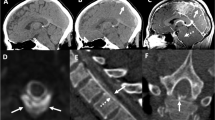Summary
A 55-year-old woman presented with headache which was characterized by aggravation in the upright position and relief in recumbency. Although intracranial hypotension syndrome was condidered to be the most-likely possible entity, computed tomography (CT) scans demonstrated subdural fluid collections associated with findings reminiscent of transtentorial herniation. Because of these CT features, cerebrospinal fluid pressure measurement by a lumbar puncture was not performed. Instead, as an alternative method, she underwent percutaneous subdural tapping, which failed to obtain spontaneous drainage of liquid haematoma, indicating intracranial hypotension. In addition, gadolinium-enhanced magnetic resonance imaging study performed later supported the diagnosis of spontaneous intracranial hypotension. Thus, the usefulness and safety of percutaneous subdural tapping for the diagnosis of spontaneous intracranial hypotension is stressed.
Similar content being viewed by others
Author information
Authors and Affiliations
Rights and permissions
About this article
Cite this article
Aoki, N., Sakai, T. & Oikawa, A. Spontaneous Intracranial Hypotension Associated with Subdural Hematoma: Diagnostic Usefulness of Percutaneous Subdural Tapping and Magnetic Resonance Imaging. Acta Neurochir (Wien) 140, 47–50 (1998). https://doi.org/10.1007/s007010050056
Issue Date:
DOI: https://doi.org/10.1007/s007010050056




